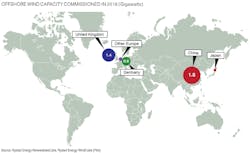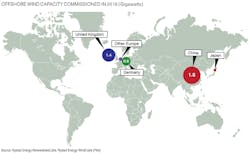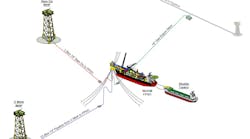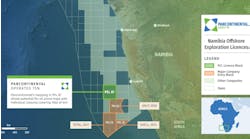China led the world in installed capacity last year
Gero Farruggio, Minh Khoi Le, Iben Fürst Frimann-Dahl, Rystad Energy
The collectivepower generation capacity of offshore wind installations worldwide grew by 4.5 gigawatts (GW) in 2018, representing less than 10% of the total global wind additions for the year. China took the lead for the first time as it added 1.8 GW of offshore wind capacity, while the UK added 1.4 GW. Changes in policies relating to offshore installations across Asia/Pacific indicate that the region will start to catch up with Europe. Most of the excitement is in developed parts of east Asia – China, Taiwan, Japan, and South Korea. However, one should not rule out the major European countries as they see a surge of capacity being added this year.
The globalgrowth in offshore wind and the emergence of newer players are also reflected in the global offshore wind spending. The global capital expenditure grew from $29 billion in 2017 to $33 billion in 2018, with the largest share of the cost tied to British, Chinese and German wind farms. In 2019, the capital expenditure is set to grow to nearly $39 billion. And while the highest spending is still seen in the major countries, such as the UK, China, Germany and other European countries, the increased spending in emerging markets is alluding to the growth story that is to come.
China
China has seen an eruption of new offshore wind projects, with a 60% increase in installed capacity in 2018 compared to 2017. The country also commissioned its largest project to date, the 400 MW SPIC Binhai North H2 in Jiangsu province, which is amongst the top 20 offshore wind projects in the world. Combined with other commissioned projects such as the Longyuan Chiang Sand H1, Jiangsu is becoming China’s most prominent province for offshore wind power.
2018 also saw a major change in Chinese wind power policy. The National Energy Administration has officially moved toward an auction mechanism, aiming for grid parity of wind projects. Projects without developers assigned and newly approved projects from 2019 will have to enter an auction where the provincial government will select winners based on a system of scoring, taking into account not just the auction price but also the bidder’s capabilities, strategy, and technology.
However, there will be no impact of policy in 2019. China approved 13.1 GW of new offshore wind capacity spreading across 12 projects in 2018, of which Shanghai Electric has the majority of capacity. These projects benefit from the previous Feed-in-Tariff (FiT) of $0.11 to $0.13 (RMB 0.75 to 0.85) per kWh, based on their respective locations.
Taiwan
Taiwan emerged as one of the most interesting new markets for offshore wind in 2018. After the country released a FiT mechanism in 2017, offering $0.19 (TWD 5.85) per kWh for 20 years, or a staggering $0.23 (TWD 7.12) per kWh for the first 10 years for offshore wind, it successfully attracted a proposed pipeline of 10.5 GW. Taiwan previously had no major offshore wind development beside the pilot 8 MW of the Formosa I Phase 1 project developed by theØrsted-Swancor consortium. Despite the lack of a supportive supply chain in country, the good FiT rate and the open market for international ownership has resulted in international developers dominating the market, with Denmark’s Ørsted taking the lead. In 2018, the government approved a total of 4 GW from this proposed pipeline.
South Korea
South Korea has an ambitious renewables growth target up to 2030. The country looks to add 48.7 GW of renewable energy to its mix, with 12 GW coming from offshore wind. However, except for the 30 MW Tamra offshore wind farm commissioned in 2017 and other single-turbine demonstrations, there was little activity in 2018. Only one project has started construction: the 60 MW first phase of the Southwest Offshore project in the North Jeolla province. When the second and third phases are included, this is the largest project currently in the pipeline in South Korea, at 2.5 GW.
More recently, big international developers such as Equinor, Copenhagen Infrastructure Partners, and Macquarie Capital have entered partnerships with South Korean companies.
Japan
Japan, looking to add 10 GW of offshore wind by 2030, faces a big technical challenge as most of its shoreline borders water depths of more than 50 m (164 ft), and extreme natural conditions such as typhoons and earthquakes are common. In addition, getting the necessary environmental approvals is normally a lengthy process, and there are grid constraints in the country. However, the Marine Renewables Energy Bill passed by the government in late 2018 will now put offshore wind projects through an auction process as well as granting developers a 30-year usage of approved wind development zones. This improvement compared to the previous policy should lead to an increase in offshore wind activities. TEPCO has since revealed plans of a 1 GW offshore wind (fixed) in partnership with Ørsted following a similar partnership between J-Power and ENGIE.
Japan has also researched floating offshore wind farms for a decade, and in 2018 commissioned another test project of 3 MW in Kitakyushu. This and the Fukushima pilot floating offshore wind project can allow for other large-scale floating wind farms to start up in the near future.
Vietnam and Southeast Asia
Despite its potential and growing demands, offshore wind development in Southeast Asia has been lackluster. Except for Vietnam, no country in the region has any significant offshore wind pipelines, even in the Philippines where onshore wind prevails. In the middle of 2018, Vietnam increased the FiT price for offshore wind projects to $0.098 per kWh, and projects need to be commissioned by the end of 2021. The country has a good pipeline for offshore wind, most of them being intertidal projects. In 2018, the 142 MW Bac Lieu Phase 3, 30 MW Soc Trang I, and 100 MW Khai Long I projects have all started construction. The largest offshore wind project currently in the country, however, is the 3.4 GW Ke Ga project that was proposed by Enterprize Energy. Given the scale of the project, it is still in the early stage and not likely to have the first phase (600 MW) completed by 2022, thereby missing the FiT. However, the government has demonstrated that it is willing to support renewables and is sticking with a FiT policy as seen from its recent solar policy.
India
India has plans to add 5 GW of offshore wind power to its mix by 2030, and currently has no offshore wind capacity installed. The National Institute of Wind Energy opened a tender to develop a 1 GW project off the Pipavav port at Gulf of Khambhat in Gujarat in April 2018. It soon attracted 35 developers, including major names such as Ørsted, Equinor, and Copenhagen Infrastructures Partners as well as other partnerships and consortiums with turbines manufacturers present. India has also been finalizing its rules for offshore sites leasing in support of this development. Developers expect the official auction for this project to be in 3Q-4Q 2019, after the election. Looking ahead, other potential zones for offshore wind development were also identified by the government, most notably off the coast of Tamil Nadu.
Australia
Australia lacks a pipeline and the necessary regulation for offshore wind, despite having favorable conditions – high wind speeds, the right shelf water depth, a healthy gross domestic product per capita, and a mature offshore service sector. The ‘lone’ Star of the South project, off the coast of Victoria, is the only proposed project to date. With little progress to date, the federal government is being pressured to establish the necessary regulatory framework by a burgeoning renewables sector in the country. With elections around the corner, we may soon be seeing the winds change.
United Kingdom
The global leader in offshore wind saw another record-breaking year in terms of additions in 2018. Although the installed capacity in the UK did not match the Chinese growth, the country commissioned more than 1.4 GW of new capacity last year. This is a slight increase from the near 1.4 GW installed in 2017, but far above the 1.1 GW installed in 2016. Among the newly commissioned plants was the Walney Extension with a total capacity of 659 MW, which stole the title of the world’s largest offshore wind farm from London Array Phase 1.
This year is expected to be the calm before the storm in terms of commissioning activity in the UK. Despite having some major projects, such as the Hornsea and Dogger Bank, coming online over the next few years, the Beatrice project is the only project set to be commissioned in 2019. This will add another 588 MW to the offshore wind capacity in the UK. However, hints of some coming major commissions are expected to appear as the Hornsea One starts generating power from the first installation of wind turbines.
The government also renewed its support for further growth in offshore wind as the Department of Business, Energy and Industrial Strategy announced in 2018 that the next Contracts for Difference auction for renewable power capacity will take place in May 2019, with the following auctions taking place every second year thereafter. This is expected to result in up to 2 GW of installed offshore wind capacity every year through the 2020s.
Germany
Germany continued its growth track by commissioning another 0.8 GW of offshore wind capacity last year, which gives it the third place both in terms of both capacity additions and total capacity by the end of 2018. The Borkum Riffgrund 2 wind farm, owned byØrsted and Global Infrastructure Partners, was the larger of the two wind farms installed that year with a total capacity of 464.8 MW. However, the Arkona Becken Südost followed close behind with its 396 MW capacity.
However, the installations in 2018 are set to be upstaged already in 2019 when EnBW commissions its 497 MW Hoho See wind farm development. This will be developed together with the Albatros wind farm, bringing the total capacity of the farm to 609 MW. Overall, Germany is forecasted to increase its offshore wind capacity by 1.2 GW this year, which is a significant ramp-up in pace from the slower growth seen over the last three years.
Conclusion
The new government policies on renewables and the pipeline of coming projects clearly show that the world of offshore wind is changing. It will no longer be dominated by only a few European players and China, but will see new Asian nations, such as Taiwan, South Korea, Japan, Vietnam, and India stepping into the spotlight to reach their targets. And with the momentum building in the US offshore wind industry, the new offshore wind majors will truly become global. •




